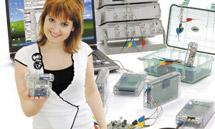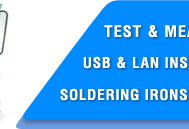







 |
||||
 |
    |
|||
 |
||||
 |
|
|||
|
Search
Log in
|
ASE-1115 Soldering Station
ASE-1115 Soldering Station is designed for lead free soldering especially. Heating up from the room temperature to 350°C in 30 seconds. This device is used in the fields of electronic research, teaching and production, especially in the repairing and soldering on the electronic appliances and communication equipment. The soldering iron tool is controlled automatically by the micro-processor. The digital control electronics and high-quality sensor and heat exchange system guarantee precise temperature control at the soldering tip. The highest degree of temperature precision and optimal dynamic thermal behavior under load conditions is obtained by the quick and accurate recording of the measured values in a closed control circuit, and this design is especially for the lead-free production technics.
Specifications:
Safety instructionsTake care of yourself!
ASE-1115 Soldering Station Operating InstructionPlace the soldering iron in the holder separately. Then connect the plug to the receptacle on the station and turn clockwise to tighten the plug nut. Check that the power supply is corresponding to the specification on the type of plate and the power switch is on the “OFF” position. Connect the control unit to the power supply and switch on the power. Then a self-test is carried out in which all display elements are switched on briefly. The electronic system then switches on automatically to the set temperature and displays this value. The display and temperature setting
The digital display: ① Shows the actual temperature of the soldering tip. ② Shows the setting temperature. Pressing the “UP” or “DOWN” button can switch the digital display to the set point display. The set-point can be changed for ±1°C by tapping the “UP” or “DOWN” button. Pressing the button will change the set-point quickly. The digital display will return automatically to the actual value and the iron will reach to the setting temperature quickly. Can control the temperature through 200°C, 300°C, 400°C button. There is °C °F convert button. ③ °C/°F display: Switching the temperature display from °C to °F by pressing the “°C/°F” button and then the electronic system will display the actual temperature ① and setting temperature ② in °F, and vice versa. ④ When the actual temperature on the soldering tip is less than the set-point, “HEAT ON” will display and make the soldering tip heating up. ⑤ When the absolute offset is more than ±10°C between the actual temperature and the set-point on the soldering tip or the nozzle, “WAIT” will display. It means that the temperature electronic control system is not in the stable situation, we should wait a moment to let the “WAIT” disappear. ⑥ When “ERROR” display, there may be a trouble on the system, or the soldering iron is not connected to the control system correctly. Suspend ModeThe soldering station integrates automatic suspend function. The station will go into suspend status if the soldering iron is not operated in 15 minutes. The temperature of the soldering tip will cool down to 200°C and keep it during the suspend mode until the station is restarted. And the station will be back to the previous working condition after restarted. You can use the below methods to restart the soldering station:
Safety Instruction
Frequently Asked Questions
Back to the section |
|||||||||||||||||||||||||||||||||||||